Bad Berneck im Fichtelgebirge
Bad Berneck (German: [baːt ˈbɛʁnɛk] (![]()
Bad Berneck i.Fichtelgebirge | |
|---|---|
Bad Berneck looking towards Holy Trinity Church and the Old Castle tower | |
 Coat of arms | |
Location of Bad Berneck i.Fichtelgebirge within Bayreuth district 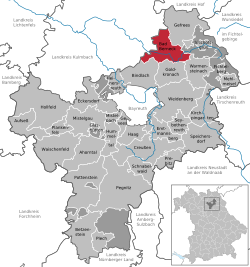 | |
 Bad Berneck i.Fichtelgebirge  Bad Berneck i.Fichtelgebirge | |
| Coordinates: 50°02′52″N 11°40′20″E | |
| Country | Germany |
| State | Bavaria |
| Admin. region | Oberfranken |
| District | Bayreuth |
| Government | |
| • Mayor | Jürgen Zinnert (SPD) |
| Area | |
| • Total | 38.25 km2 (14.77 sq mi) |
| Elevation | 393 m (1,289 ft) |
| Population (2018-12-31)[1] | |
| • Total | 4,371 |
| • Density | 110/km2 (300/sq mi) |
| Time zone | CET/CEST (UTC+1/+2) |
| Postal codes | 95460 |
| Dialling codes | 09273 |
| Vehicle registration | BT |
| Website | www.badberneck.de |
Geography
The town of Bad Berneck lies on the western edge of the Fichtelgebirge in the Ölschnitz valley, which enters the White Main below the old town or Altstadt. The Mainberg (624 m above NN) and Wolfenberg (598 m above NN) are the highest peaks in the parish.
Neighbouring communities
Bad Berneck's neighbouring parishes (in clockwise order) are: Gefrees, Goldkronach, Bindlach, Harsdorf, Himmelkron and Marktschorgast. The town of Bayreuth is about 13 kilometres (8.1 mi) from Bad Berneck.
Sub-divisions
|
|
|
|
|
|
|
|
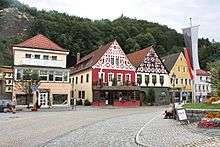
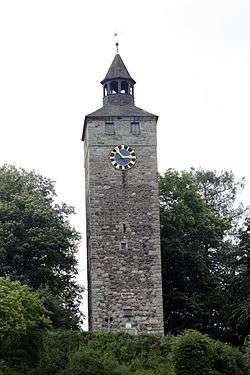
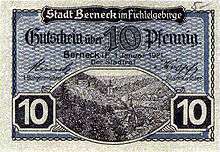
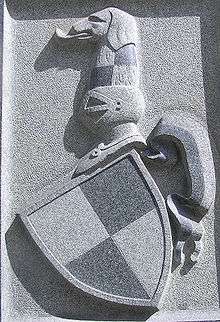
History
The exact date of Bad Berneck's foundation is not known, but up to 1057 the place was under the control of the lords of Babenberg and later the counts of Andechs. In 1167 Berneck was first mentioned as a castle, built by Ulrich II Walpote of Berneck, without obtaining the approval of the Bishop of Bamberg.
Until 1202 Berneck was under Bamberg rule. From 1203 to 1248 it belonged again to the counts of Andechs-Merania. In 1248, following the extinction of House of Merania, it fell to the counts of Orlamünde and in 1341 to the burgraves of Nuremberg (and, later, the margraves of Brandenburg-Bayreuth). It is first recorded as a town on 18 November 1357. In 1375 Berneck was almost completely burned down and it was destroyed by fire again in 1431 and 1462 during the Hussite Wars. Plague and famine also struck the town. In 1478 the Marquis gave Berneck to Veit von Wallenroth with the stipulation that the fortifications were to be rebuilt. The castle of Hohenberneck [2] was built. In 1495 the town had 204 residents in 76 households. After the death of Veit von Wallenroth the place went to Albert of Wirsberg, the Amtmann of Stein. He further fortified the now ruined stronghold and the family acted as robber barons against Nuremberg. The latter had the castle bombarded into ruins in 1533. In 1632, in the middle of the Thirty Years War the place was razed. This happened again on 13 May 1692 - only five houses and a mill were spared.
In 1724, 15 gypsy women were hanged and buried under the Gypsy Oak (Zigeunereiche). The men had fled. The survivors were driven across the border.
In 1732 Margrave George Frederick Charles of Brandenburg-Bayreuth had pearl oysters introduced into the Ölschnitz, probably to supplement the state's finances In the wars of 1796-1815 the small town had to pay several contributions and provide billeting. In 1806 Blücher visited Berneck and the Blüchersruh was named after him. The former office (Amt) of the Prussian principality of Bayreuth, established since 1792, fell to France in 1807 as a result of the Treaty of Tilsit and, in 1810, went to Bavaria. Around 1830 the first spa business was established (based on whey products). Within Bavaria, Berneck was initially the seat of a regional court (Landgericht), later a district office (Bezirksamt). The territory of the district was affiliated to the neighbouring district offices of Bayreuth, Kulmbach and Münchberg. The majority of the Amt territory was controlled by the district office at Bayreuth. In 1896 it was connected to the railway network.
On 1 October 1929 the district of Berneck was dissolved. In the 1930s, Adolf Hitler spent the night in the then fashionable Bube Hotel on several occasions during the festival in Bayreuth. In 1930, Kneipp cures were introduced and its recognition as a spa came in 1950. However, since the 1970s, its role as a spa has tailed off considerably.
Politics
Culture and points of interest
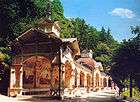
- Ruins of the Walpote castle of Wallenrode, Hohenberneck Castle, the Old Castle and St. Mary's chapel, and the water castle of Alt-Berneck.
- Dendrological Gardens in the Rother Park with trees from all over the world.
- Market place with historic timber-framed houses.
- Spa park with colonnades.
- The open air stage by the Castle Tower is used from June to September by the Free Theatre of Bayreuth.
- Protestant church of the Holy Trinity (Zur Heiligen Dreifaltigkeit).
Economy and infrastructure
The largest employer in the town is the Frenzelit-Werke, with approximately 450 employees worldwide. The company is owned by the Wagner family and manufactures seals. The second largest employer was Reitz group, with about 200 employees in Bad Berneck (about 500 total). The Reitz Group with its brands Popp, düwi and Schwaiger manufactures electrical products. On 18 February 2009 the Reitz group filed for bankruptcy.
Transport
Bad Berneck lies at the intersection of B 2 (Hof-Bayreuth) and B 303 (Kronach -Eger) federal highways. Bad Berneck is connected to the motorway network via the junction of Berneck/Himmelkron (5 km distant on the A 9 and A 70 motorways. The nearest railway stations are located in Marktschorgast, Neuenmarkt and Bayreuth.
Education
Bad Berneck has the Sebastian-Kneipp Volkschule (primary and secondary school) and two kindergartens.
People
Sons and daughters of the town
- Adolf Köberle (1898-1990), Protestant theologian
- Carl Heidenreich (1901-1964), German-American painter
- Carl Zimmerer (1926–2001), German state and social scientist, economist and entrepreneur
- Simon Nüssel (1924-2015), German politician (CSU and Bayernpartei); was Bavarian State Minister for agriculture and forestry from 1987 to 1990.
People who lived and worked in Bad Berneck
- Ulrike Meinhof (1934-1976) lived in Bad Berneck from 1945-1946 together with her mother, Ingeborg Meinhof, and Renate Riemeck
References
- "Fortschreibung des Bevölkerungsstandes". Bayerisches Landesamt für Statistik und Datenverarbeitung (in German). July 2019.
- Dr. Hans Vollet und Kathrin Heckel:''Die Ruinenzeichnungen des Plassenburgkartographen Johann Christoph Stierlein. 1987.
- http://www.bad-berneck.com/sta.html%5B%5D
External links
| Wikimedia Commons has media related to Bad Berneck im Fichtelgebirge. |
| Wikisource has original text related to this article: |